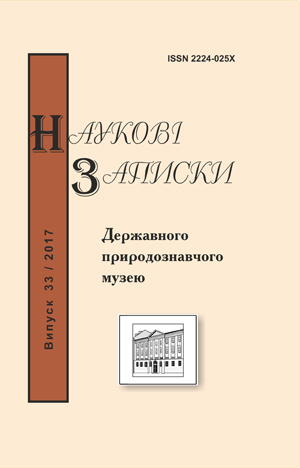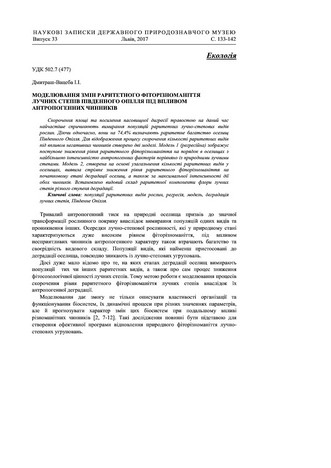Dmytrash-Vatseba I.I. Modelling of rare plant species diversity changes by anthropogenic factors in meadow steppes of the Southern Opillya // Proc. of the State Nat. Hist. Mus. - Lviv, 2017. - 33. - P. 133-142.
DOI: https://doi.org/10.36885/nzdpm.2017.33.133-142
Key words: Rare plant species populations, regression, model, meadow steppes degradation, the
Southern Opillya
Nowadays, area decrease and pastoral digression enhance are determinative factors for the extinction of rare plants populations. Making their cumulative impact on rare fraction of meadow steppes, these negative factors govern 74.4 % of habitats richness in the Southern Opillya. Two models were built to demonstrate the process of rare species number reduction under stress of the negative factors. Model I (regression model) displays a graduate ten times reduction in rare plant diversity rate with increasing of the factors intensity. Model II was developed based on generalized dataset of rare species number in habitats. It reveals an abrupt reduction of rare plant richness at the very beginning of habitat degradation, also at the last stages of this process. A species composition of rare fraction of flora for meadow steppes at different degradation level is presented.
References
- Vinichenko T.S. Roslyny Ukrainy pid okhoronoiu Bernskoi konventsii. – K.: Khimdzhest, 2006. – 159 s. [In Ukrainian]
- Zlobin Iu.A., Skliar V.G., Klimenko A.A. Populiatcii redkikh vidov rastenii: teoreticheskie osnovy i metodika izucheniia. – Sumy: Universitetskaia kniga, 2013. – 439 s. [In Russian]
- Sobko V.H. Fitorarytety Ukrainy u svitovomu chervonomu spysku. – K.: Fitosotsiotsentr, 2005. – 155 s. [In Ukrainian]
- Chervona knyha Ukrainy. Roslynnyi svit / za red. Ya.P. Didukha. – K.: Hlobalkonsaltynh, 2009. – 900 s. [In Ukrainian]
- Sheliag-Sosonko Iu.R., Andrієnko T.L., Osichniuk V.V., Dubina D.V. Osnovnye tendentcii antropogennykh izmenenii rastitelnosti Ukrainy. – Bot. zh. – 70 (4). – S. 451 -463. [In Russian]
- Shmidt V.M. Matematicheskie metody v botanike. – L.: Izd-vo Leningr. un-ta, 1984. – 288 s. [In Russian]
- Forbis de Queiroz T., Baughman C., Baughman O., Gara M., Williams N. Species Distribution Modeling For Conservation Of Rare, Edaphic Endemic Plants in White River Valley, Nevada // Natural Areas Journal. – 2001, vol. 32(2). – P. 149-158.
- Gotelli N.J., Colwell R.K. Quantifying biodiversity: procedures and pitfalls in the measurement and comparison of species richness // Ecology Letters. – 2001, vol. 4. – P. 379-391.
- Grace J.B., Pugesec B.H. A structural equation model of plant species richness and its application to a coastal wetland // The American Naturalist. – 1997, vol. 149, № 5. – P. 436- 460.
- Lobo J.M., Castro I., Moreno J.C. Spatial and environmental determinants of vascular plant species richness distribution in the Iberian Peninsula and Balearic Islands // Biological Journal of the Linnean Society. – 2001, vol. 73. P. 233–253. doi:10.1006/bijl.2001.0543, available at: http://www.idealibrary.com
- Luoto M. Modelling of Rare Plant Species Richness by Landscape Variables in an Agriculture Area in Finland // Plant Ecology. – 2000, vol 149 No 2. – P. 157-168.
- Mao Ch.X., Colwell R.K. Estimation of species richness: mixture models, the role of rare species, and inferential challenges // Ecology. – 2005, 86(5). – P. 1143-1153. Mosyakin S., Fedoronchuk M. Vascular plants of Ukraine. A nomenclatural checklist. – Kyiv, 1999. – 346 p.
- Nantel, P., Gagnon D., Nault A. Population viability analysis of American Ginseng and Wild Leek harvested in stochastic environments // Conservation Biology. – 1996, vol. 10. – P. 608-621.
- Shaffer M.L. Minimum population sizes for species conservation // BioScience. – 1981, vol. 31 . – P. 131 -134.


